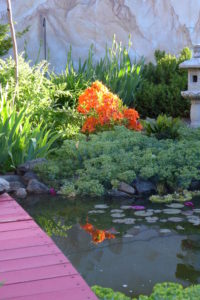 We painted the garage wall in imitation of a Chinese painting—painted it first in mud—real mud, from the ground—so we could get the feel we wanted, hosed off the bits we didn’t like, then re-did them.
We painted the garage wall in imitation of a Chinese painting—painted it first in mud—real mud, from the ground—so we could get the feel we wanted, hosed off the bits we didn’t like, then re-did them.
Then we got a selection of little sample paint pots from Ace Hardware, and started in on a permanent image, incorporating the mud right into the work in some few places, but mostly just operating from the faint trace left after hosing off a section. We finished it with a transparent layer. And it’s a lot nicer than the blank white wall we started with, kind of organic, like the garden.
The snow-viewing lantern (that’s what they’re called: you can judge the depth of the snow by how much piles up on it, I suppose. We do) was a gift from an early Shejicon, one we light at night on special occasions, and to remember people we’ve lost. It casts a beautiful reflection of light on the pond. We greatly treasure it.
The bridge stands in a little need of repair, but I know how to do it. The problem stems from my choice of 12×2’s, not knowing that they’re a composite board, not a single piece of wood. It is slowly coming un-composited. We are going to ‘sister’ some plywood to it and repaint, and it will be strong enough to hold several people. Right now, one of us is a risk.

Great pics! Nice sizing.
No snow here – never snow in Adelaide, but we reached 40C the other day.
Snow? These alien, foreign words you use…. ;D
@CJ — What are the Latin forms of the word for Snow, that could be used for personal names? I’m looking for something for a male name, but I’d want the female form too, or even a neutral form. As best I can tell, “Nix?” was the nominative for plain old snow, and “Nivea” is a modern invention for a brand name, but the “e” instead of “i” is, well, call it modern poetic license because it sounded good to them. The descendant forms I know of are, “Nieves” (Snows, feminine, Spanish) and “Neige” (Snow, feminine, French) as in Blanche Neige, Snow White, and with the adjective unusually before the noun in French for emphasis and as a name, while the English form is archaic with the adjective after the noun, formerly common usage. Then there’s “Nevada” (and Nevadas, Nevad, Nevados) the Spanish forms for “Snowed, Snowy.” So I get that the Latin stem was “*niv(i)-” or “*niv(e)-“, and the participial / adjectival form, probably “niviata, niveata,” or maybe it was an -ere or -ire instead of an -are verb? Thanks, and please forgive the linguistic tangent.
My first reaction to the azaleas photo? “Oh, that’s PURTY!” … No, I don’t know where that came from either.
The idea for the mural, starting with mud, using paint samples, incorporating the mud, sealing it with a transparent glaze…. Y’all (CJ and Jane), that is a most brilliant and wonderfully creative thinkum. Fantastic, I love it!
Watch out for people with dictionaries!
Cassell’s Latin:
nix, nivis (f) – snow, often used in the plural form; also used of hair
nivālis, nivāle – of snow, snowy, and also used for “snow-white” (Virgil) and “cold” (Martial)
nivātus, nivāta, nivātum – cooled with snow, iced (Suetonius)
niveus, nivea, niveum – of snow, snowy; snow covered; and also used for “white as snow” or “snowy”
nivōsus, nivōsa, nivōsum – abounding in snow, snowy
Nivatus, Nivalis, Nivale, Nivata, Niveus and Nivosa seem “name-like” to me. Nivale, Nivata, and Nivosa for female names, and the others for male names. Don’t know the Latin stress patterns, but a name like NI-va-le, with the stress on the first syllable sounds pretty for a woman IMO.
Niveus = ‘snowy’ is the primary adjective from ‘nix, nivis’. It could be used as a name. Nivea is the feminine form, and is presumably the origin of the brand name.
Snow — nix. Of snow — nivis.
Aha! Thank you all! That helps considerably.
Interesting that they had “niveus, nivea, niveum,” for snowy, then “nivosus, nivosa, nivosum” for “abounding in snow,” not just, “very snowy,” but, “whoa, can’t see the roof!” snowy.
I don’t know if “-os-” was an ending or infix as an intensifier (like “-issimo, -issima” is now), for “super, extra, ultra,” but at least that says they had use for the two options, regular, and, er, super-sized snowfall. Having a way to turn a modifier (adj., adv.) into a super-modifier (beyond -er and -est) seems really handy as a regular feature, from a conlang or linguistics standpoint.
Thank you! Just what I needed. 😀
I am grateful that you still use the snow-viewing lantern. I’m glad to have made a small contribution toward that gift for you and Jane at ShejiCon III (“Arsenic and Old Lace”) and the “Space Pirate Party”.
Ah, those were fun parties. And we do love that lantern.
You and Jane have created such a little world of beauty chez vous. The mural is brilliant, and everything I see of the garden just looks so like a garden that has matured through centuries of careful nurturing.
This year the poor garden was sadly neglected (kitchen remodel), but it’s mature enough that most things have kept to their beds and behaved themselves.
Fishy went a little heavy on the eye makeup there!
When you do the bridge rebuild, see if you can get marine-grade plywood, which will be much more weather resistant than the standard indoor variety.